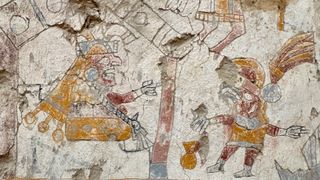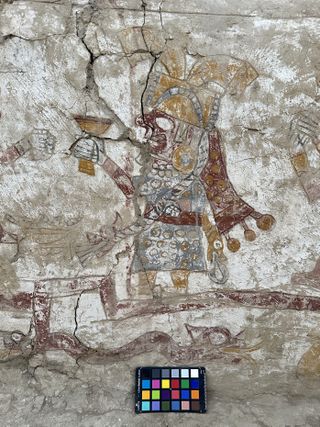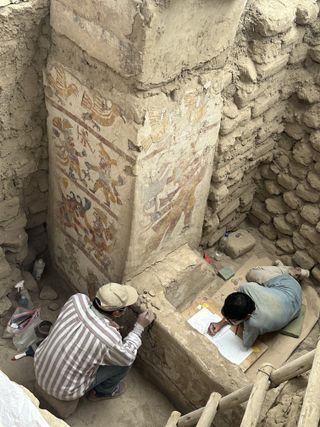1,300-year-old throne room of powerful Moche queen discovered in Peru
Archaeologists in Peru have unearthed the throne room of a powerful queen from the Moche culture, and detailed murals of the female ruler decorate its walls.

Archaeologists in Peru have discovered a 1,300-year-old throne room painted with murals depicting a female Moche ruler, although they have yet to find the queen's skeletal remains.
This throne room, found at the archaeological site of Pañamarca, dates to the seventh century A.D., when the Moche were thriving in the area, archaeologists said in a statement. The Moche flourished in northern Peru between roughly A.D. 350 and 850 and are known for building elaborate buildings and tombs, as well as for constructing intricate works of art, such as ceramics that depict human faces. They lived before writing was used in Peru.
Although other female rulers are known from pre-Incan Peru, "a throne room for a queen has never been seen before at Pañamarca, nor anywhere else in ancient Peru," the statement reported.
The throne is made of adobe and contains the remains of greenstone beads and human hair. The hair may be from the queen, and researchers plan to conduct DNA tests on it.
Related: Skeletons of Incan kids buried 500 years ago found marred with smallpox
Murals depicting the ruler were found on the pillars and walls of the throne room, and even on the throne itself. They depict the queen in a variety of ways. One shows her wearing a crown and raising a goblet. Another depicts the crowned woman carrying a scepter, with a procession of men carrying textiles and other objects to her. Yet another features her sitting on her throne and speaking to an individual who appears to be part man, part bird.

The queen's tomb and skeletal remains have yet to be found. "We don't have any evidence of a tomb at this time," Michele Koons, director of anthropology at the Denver Museum of Nature and Science and one of the excavation leaders, told Live Science in an email. If the queen's tomb does exist at the site, it was likely looted at some point, Koons said.
Sign up for the Live Science daily newsletter now
Get the world’s most fascinating discoveries delivered straight to your inbox.
What sort of kingdom the female ruler reigned over is not clear. "The nature of the political organization of the Moche people is a hot topic in Moche studies," Koons said. "There is evidence for the Moche culture consisting of independent polities that interacted with one another," Koons said, noting that these polities may have shared similar religious ideas and art styles.

In Moche culture, it was not unusual for women to become rulers. "Female leaders were not rare in ancient Moche society or in the northern Peruvian dynasties that followed," Koons said. Much of the evidence for female rulers comes from tombs, she added. These include the "Señora de Cao," the tomb of a female Moche mummy that was buried with elaborate jewelry, ornaments and weapons, such as clubs and atlatls, or devices which help throw spears and darts farther. It was found at the site of Huaca El Brujo in 2006 and appears to be a high-ranking individual, possibly a ruler.
Koons noted that modern-day archaeologists likely misidentify high-ranking female burials. "High status burials of Moche men have more often than not been described as 'lords' but women as 'priestesses,'" Koons said, noting that some of the "priestesses" may actually be rulers.
Scholars have been researching Pañamarca for more than 70 years with murals first being discovered in the 1950s. The team started their research project in 2018 and in August 2022 discovered two murals showing two-faced men in a ceremonial hall at Pañamarca.

Owen Jarus is a regular contributor to Live Science who writes about archaeology and humans' past. He has also written for The Independent (UK), The Canadian Press (CP) and The Associated Press (AP), among others. Owen has a bachelor of arts degree from the University of Toronto and a journalism degree from Ryerson University.
Most Popular



